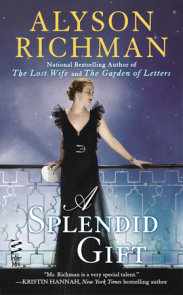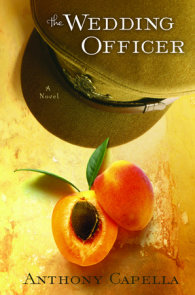READERS GUIDE
Questions and Topics for Discussion
INTRODUCTION
Upstate New York, 1928. Laura Kelley and the man she loves sneak away from their judgmental town to attend a performance of the scandalous Ziegfeld Follies. But the dark consequences of their night of daring and delight reach far into the future.…
That same evening, Bohemian poet Edna St. Vincent Millay and her indulgent husband hold a wild party in their remote mountain estate, hoping to inspire her muse. Millay declares her wish for a new lover who will take her to unparalleled heights of passion and poetry, but for the first time, the man who responds will not bend completely to her will.…
Two years later, Laura, an unwed seamstress struggling to support her daughter, and Millay, a woman fighting the passage of time, work together secretly to create costumes for Millay’s next grand tour. As their complex, often uneasy friendship develops amid growing local condemnation, each woman is forced to confront what it means to be a fallen woman…and to decide for herself what price she is willing to pay to live a full life.
ABOUT ERIKA ROBUCK
Erika Robuck is a contributor to the popular fiction blog Writer Unboxed, and she maintains her own blog, Muse. She is a member of the Hemingway Society, the Millay Society and the Historical Novel Society, and she lives in the Chesapeake Bay area with her husband and three sons. She is the author of Receive Me Falling and Hemingway’s Girl.
A CONVERSATION WITH ERIKA ROBUCK
What inspired you to make Edna St. Vincent Millay the subject of your third literary-themed novel?
My studies of the Fitzgeralds for my novel Call Me Zelda led me to Millay. Two of F. Scott Fitzgerald’s Princeton friends, Edmund “Bunny” Wilson and John Peale Bishop, worshipped Millay, and their adoration of her reminded me of my interest in her poetry, which I first read in college. Wilson’s moving obituary for Millay in his essay collection Shores of Light inspired me to learn more about the poet who had such an “intoxicating effect on people.” It didn’t take long for Millay to cast her spell on me.
A poet, a seamstress, and a sculptor-there’s something poetic about that combination. How did you come up with it?
My visit to Millay’s home Steepletop, a seven-hundred-acre estate in the Berkshires, inspired the characters in my story. When I first saw photographs of the pastoral place, I imagined what an ideal retreat it must have been for Millay, where she could compose her poetry in peace. On my visit, however, I realized this was not necessarily so.
First, Steepletop is very remote. Traveling the winding mountain roads bordered with forests reminded me of the opening of Stephen King’s The Shining. Once I arrived, I was struck by two things: First, it was almost blindingly bright, and, second, the terrible buzzing of bees could be heard everywhere. When I entered the house, the blank-eyed gaze of the large black bust of Sappho in Millay’s parlor made me uncomfortable, and I was further disturbed to stand in the foyer at the bottom of the staircase, where Millay had fallen to her death.
When I walked upstairs into Millay’s rooms, I was interested to see elaborate robes hanging in her bathroom, and to learn about her dramatic reading tour wardrobes. I was reminded of the poetry collection for which she won the Pulitzer, The Harp-Weaver and Other Poems, about an impoverished mother who magically weaves her son’s fancy clothing on a harp until she dies.
All of these research ingredients blended in my imagination to form and connect my poet, seamstress, and sculptor.
Millay’s desire to plumb the heights and depths that life could offer, all in service to her poetry, makes her a fascinating figure. Why do you think we are drawn to her, and people like her? Do we secretly wish we had the courage to go where she dares to go? And as a writer yourself, how do you reconcile the need to feed your creative muse while remaining a responsible, “highly functioning” grown-up?
Women like Millay, who live so fiercely on the edge of what mainstream society might consider scandalous, are captivating in any time period. What I found most interesting about Millay and her husband was their belief that her experiences in life, love, lust, and pain were part of her vocation, and, therefore, worthy of being taken as far as she was willing to go. I’m sure we all have secret thoughts and fantasies that we either let loose or rein in, depending on how impulsive we are, how ingrained our moral beliefs are, or any number of other factors, but those who flout convention make fascinating characters.
So far my imagination has been able to supply all of my edgy material, much to my husband’s relief.
In the last few months, I’ve comes across several mentions of Millay. Caroline Kennedy has quoted Millay’s “First Fig” in interviews and suspense writer Sophie Hannah has called Millay one of her five favorite writers. Are we poised for a Millay renaissance?
I’m intrigued by the idea of Millay’s second renaissance, since it was her poem “Renascence,” selected for an annual poetry anthology when she was just twenty years old, that initially made her a celebrity.
In Millay’s own time, she sold out thousand-seat auditoriums on reading tours. Her adoring fans sent her endless correspondence about her poetry. Her collections were continuously being reprinted, and she was one of the first women to win the Pulitzer Prize. At her peak, Millay’s writings made her approximately thirty thousand dollars a year, which would be nearly half a million dollars in the present day. Our time is rich with captivating women artists, musicians, and writers, and Millay is worthy to stand with the best of them.
I believe our culture is poised not only for a Millay renaissance, but also for a poetry renaissance. As our attention span constricts in response to the gadgets we use, poetry could supply a new consciousness with deep meaning in short form.
Through the character of Laura Kelley, Fallen Beauty explores what it meant to be a “fallen woman” in the 1930s, but in some ways, Edna St. Vincent Millay might also be considered a fallen woman. Would you share some of what you hoped to convey in this regard?
I wanted to show how making judgments about people injects poison into communities, how frequently all is not what it seems, and how those who outspokenly oppose something that they see as corrosive are often battling aspects of the very behavior they denounce.
Through the women in particular in Fallen Beauty, I wanted to explore how we seek fulfillment, what it means to be an “ideal” woman (if there is such a thing), how our desires can either help to build us up or destroy us, and how we can remake our lives after we fall.
You mentioned once that car accidents were a hallmark of novels set in the twenties and thirties, which came as a surprise to me. Can you explain?
The use of the automobile accident, or the vehicle as a symbol of violence for dramatic effect, is typical of works set in the twenties and thirties, when driving became more prevalent and cars were associated with certain freedoms. F. Scott Fitzgerald uses a car accident in This Side of Paradise and at the climax of The Great Gatsby. In Appointment at Samarra by John O’Hara, the car becomes a device for suicide. In 1936, Millay was in a car accident with Eugen in the driver’s seat, in which she was flung out of the vehicle and into a ravine. Afterward, she suffered permanent problems with her back, which led her to abuse prescription drugs. A car accident seemed a fitting device for illustrating the trouble that becomes the catalyst for events in Fallen Beauty.
Edna St. Vincent Millay seems to have been especially close to her mother. Can you tell us more about Edna’s upbringing and family dynamics? Were her two sisters at all like her? And does she have any descendants through her sisters?
After her scandalous divorce from her husband in 1900 for gambling, Cora Millay raised her three daughters alone, often leaving the girls for long periods to work as a practical nurse. Cora insisted on the education and betterment of her girls in spite of their poverty, and she was their greatest champion and supporter. They worshipped her, and Vincent was said to enjoy her times of illness because Cora would stay home to take care of her.
Vincent’s sisters, Norma and Kathleen, were artists in their own rights. Norma was an actress in the theater and Kathleen was a writer, though she existed in Vincent’s shadow. Neither had any children.
Biographers have noted the extreme closeness of the women, saying that they often lived and socialized together, wrote poetry for one another, and crafted strange, almost adoring letters to one another. I found Vincent’s “love letters” to her mother both charming and unsettling.
The three novels we’ve worked on together all explore the idea of redemption in one way or another. Is that a deliberate choice, or a theme that cropped up without your being aware of it?
I believe it was F. Scott Fitzgerald who said that writers have only one story to tell, so I suppose redemption is my story. My mission with Ernest Hemingway, Zelda Fitzgerald, and now Edna St. Vincent Millay is to show their humanity through their fascinating lives in order to honor them and remind readers of their work. I like to read novels that offer redemption in spite of hardship, so it’s only natural that I employ similar themes in my own fiction.
You’ve now explored in your novels Ernest Hemingway, Zelda Fitzgerald, and Edna St. Vincent Millay-all of whom were contemporaries of one another. From your current perspective, are there any commonalities you see in their lives and work, or any conclusions we can draw-however tentatively-about their relevance for our own time?
Commonalities I’ve discovered are the way they used real people in their fiction, often without regard for the feelings of those being exploited, though all three approached this differently. Hemingway fictionalized his experiences after he’d had them. Zelda wrote autobiographically, often exposing her own personality flaws and insecurities. Millay was in love with love more than she was with the people who received her brand of love, and she used those heightened emotions to inspire her poetry. In each instance, the writings seem corrosive to those involved, though the work is often brilliant.
As a writer, I’m interested in understanding the creative mind, and just what is necessary to make great art. I find that question relevant to any time. Stories are what help us make sense of and empathize with one another. Perhaps by studying the lives of others, we can learn from their mistakes. Millay often wrote about nature and the cycle of the seasons in her poetry, and she used nature’s lessons to comfort and instruct herself in love. History has cycles, and examining the past helps us to anticipate the future.
Are you ready to share the subject of your next novel?
The subject of my next novel is a very private gentleman from a long time ago who often felt isolated in spite of being surrounded by his loving family and accomplished contemporaries. I will not yet reveal his name, but I will say that through him, I will explore loneliness and, most certainly, redemption.
DISCUSSION QUESTIONS






















